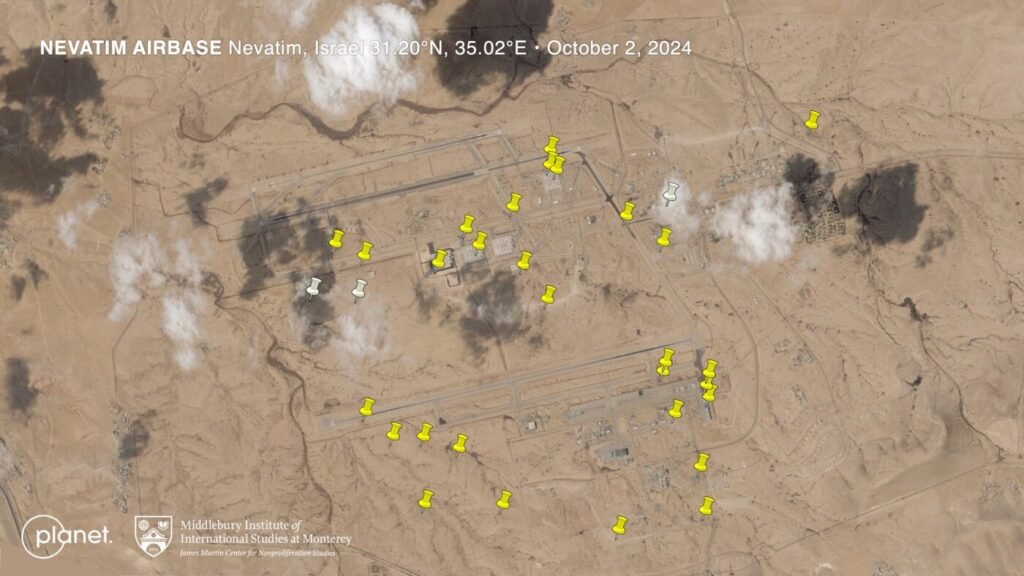Satellite tv for pc photographs present dozens of Iranian missiles struck close to Israeli air base : NPR


Researchers counted about 32 factors the place missiles landed round Nevatim Airbase in southern Israel. Israel says no fighter jets had been destroyed and the bottom continues to function.
Middlebury Institute of Worldwide Research at Monterey/Planet Labs PBC
cover caption
toggle caption
Middlebury Institute of Worldwide Research at Monterey/Planet Labs PBC
Researchers have used business satellite tv for pc imagery to determine greater than 30 factors the place Iranian missiles seem to have impacted an air base in southern Israel.
The imagery, taken by the corporate Planet the day after the strike, exhibits broken hangars, buildings, taxiways, and a crater on one of many runways at Nevatim Airbase. Movies posted to social media confirmed a number of warheads placing the bottom in the course of the Oct. 1 assault by Iran.

A element of satellite tv for pc imagery from the corporate Planet exhibits harm on one of many runways.
NPR/Planet Labs PBC
cover caption
toggle caption
NPR/Planet Labs PBC
Israel and the U.S. have downplayed the assault, which Israel says consisted of roughly 180 ballistic missiles. Israel stated many had been intercepted by its missile defenses. Two U.S. destroyers additionally fired a few dozen interceptors to try to blunt the strike.
“This assault seems to have been defeated and ineffective,” U.S. nationwide safety adviser Jake Sullivan stated shortly after the missiles fell.
“Our air pressure and air pressure bases stay operational,” an Israeli army spokesperson, Lt. Col. Peter Lerner, stated in a briefing on the social media platform X.
The Israeli army says no planes had been destroyed within the assault.
A fancy image
However Jeffrey Lewis, a professor on the Middlebury Institute of Worldwide Research at Monterey who led the evaluation, says his work “complicates the image loads.”
“We see greater than 30 craters and broken buildings,” Lewis says, “suggesting that greater than 30 missiles hit the bottom.”

A picture of Nevatim Airbase taken on Oct. 2 exhibits harm to a hangar and a taxiway brought on by Iranian missile strikes.
Planet Labs PBC
cover caption
toggle caption
Planet Labs PBC
Iranian missiles additionally struck one other base, Tel Nof Airbase in central Israel, and a smaller variety of missiles fell close to the headquarters of Israeli’s intelligence company, referred to as Mossad.
Primarily based on preliminary calculations of what occurred at Nevatim, Lewis believes a considerable variety of Iranian missiles might have reached their targets.
“If Nevatim is consultant, that will counsel that greater than half acquired by means of,” he says.
Choose and select
Their are a number of explanation why so many Iranian missiles might have penetrated Israel’s air defenses. Israel’s vaunted Iron Dome missile protection system can solely intercept low-flying, short-range missiles of the kind utilized by Hezbollah and Hamas. To intercept Iran’s medium-range ballistic missiles requires Israel’s extra highly effective and costly Arrow 2 and Arrow 3 missile protection techniques.
It’s attainable that the Arrow system didn’t carry out as anticipated, Lewis says, however he thinks it is extra probably that Israel might have determined to not defend Nevatim, to be able to save its interceptors to guard inhabitants facilities like Tel Aviv.
“It might be that they only do not have that many Arrow 2 and Arrow 3 missiles,” Lewis says. If that had been true, then “the Iranians have succeeded in overwhelming the system and the Israelis have needed to choose and select.”

A view of a automobile broken in Tel Aviv by Iran’s assault. Comparatively few missiles acquired by means of to Israel’s largest metropolis, suggesting that the army might have chosen to defend it over its air bases.
Getty Photographs/Anadolu
cover caption
toggle caption
Getty Photographs/Anadolu
“That will be my guess,” Lewis provides. “It didn’t seem like they had been making an attempt to defend this base.”
Lewis notes that though over 30 missiles landed inside the bottom perimeter, the harm brought on was nonetheless considerably restricted. That is notable as a result of Iran is believed to have used a few of its most superior Fattah missiles.
“Even these missiles, which look considerably extra correct, nonetheless struggled to do harm,” he says.
Nonetheless, he thinks the assault has proven that Iran can strike at targets properly inside Israel. “They’ll positively get missiles by means of,” he says.






